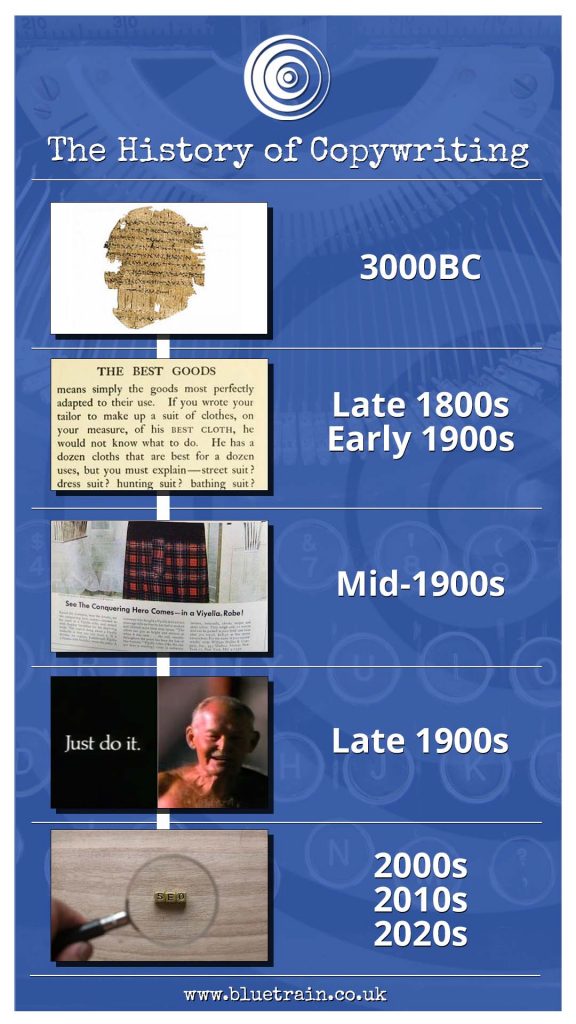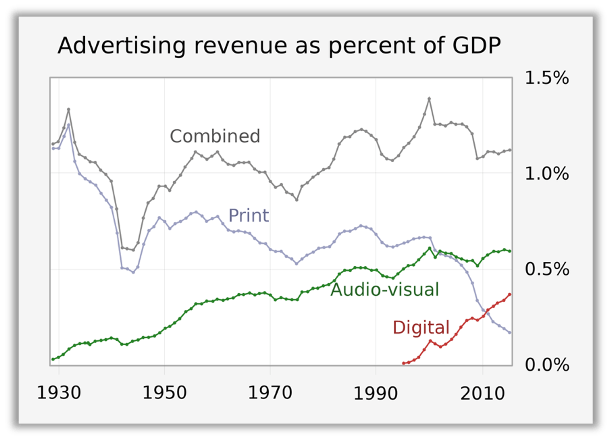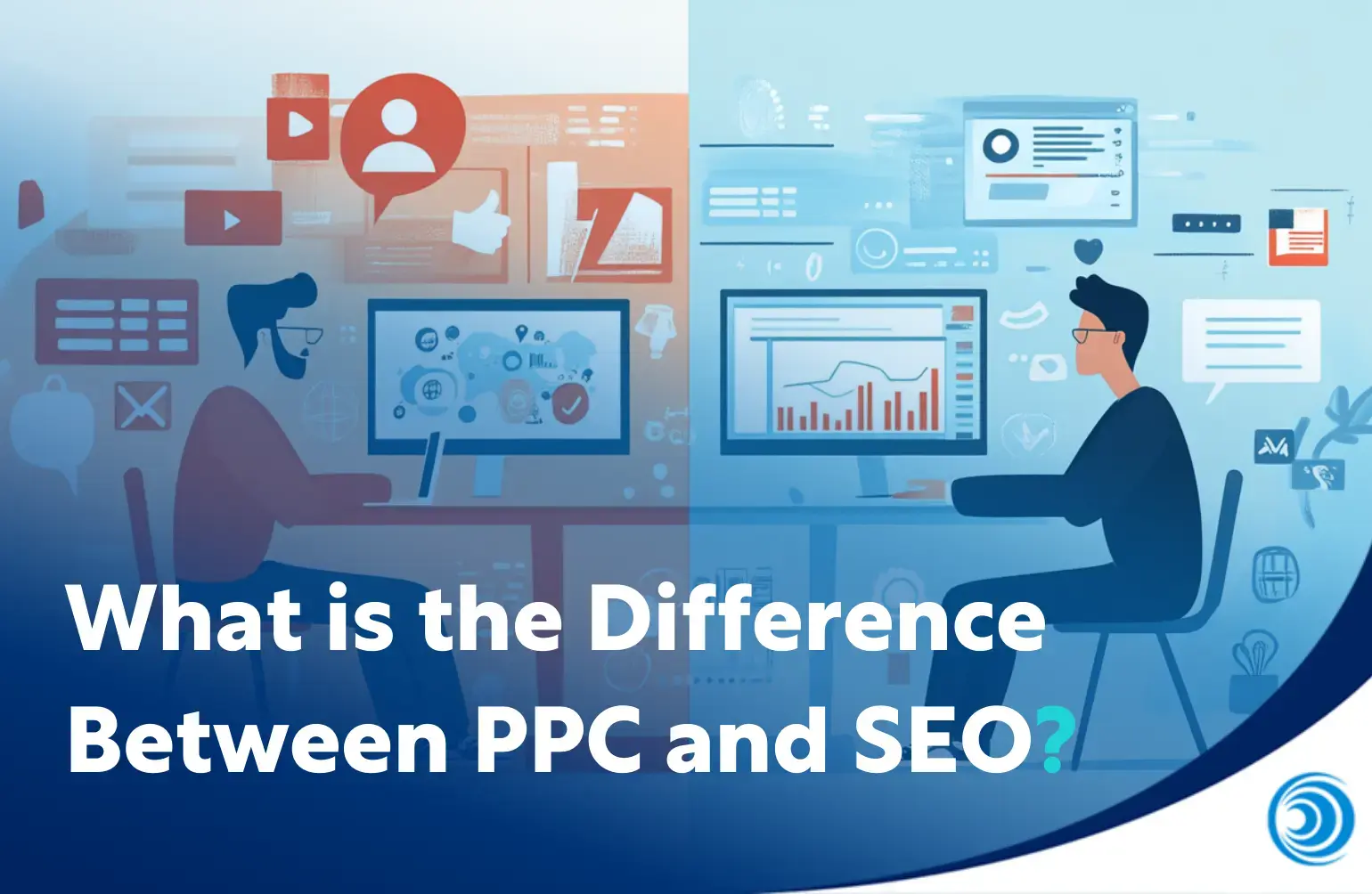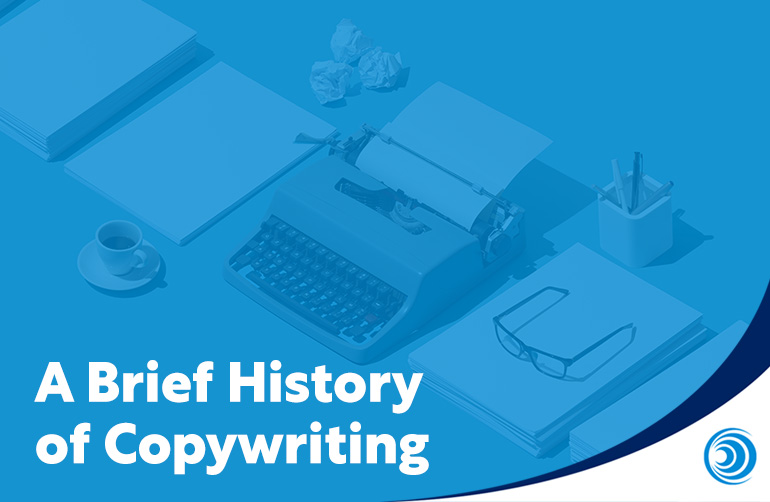
A Brief History of Copywriting
Copywriting is a fundamental element of marketing. It can make or break a brand or campaign.
The best examples can make the art of copywriting look breathtakingly simple.
But where did this art come from?
In other words, when did copywriting begin? Who are its most famous exponents? How has it changed? And where is it heading?
In this article, we will look at:
What is copywriting?
The Oxford Dictionary defines copywriting as:
the activity or occupation of writing the text of advertisements or publicity material.
In English, the term has been around since the late nineteenth century.
‘Copy' as a noun meaning ‘text' dates back to the fifteenth century, when texts would often have to be literally copied.
Nowadays, copywriting can range from writing long-form documents (there is also a large overlap with content creation) to short slogans.
It covers everything from tone of voice to more specific phraseology that defines a brand.
Other copywriting-related terms
Copywriting often gets mixed up with other terms.
For example, copywriting and copy-editing are related but different. Copy-editing is the editing of texts (including texts with copywriting, but also other kinds, too) with various goals in mind.
It (copy-editing) is not to be confused with proofreading, which is more focused on correcting typos and grammar rather than shaping the texts.
And content writing is different to copywriting, too. The former is about writing blogs, not creatively focusing on impactful phrasing.
The history of copywriting
Writing has emerged independently across multiple eras and locations.
A lot of what could have been evidence for copywriting has probably disappeared, lost to history forever.
1. Earliest forms of copywriting
There are many claims online of early forms of advertising, many of which use copywriting.
Once such claim is made for ‘The Shem of Papyrus' (a papyrus was a type of scroll), from 3,000BC. It is essentially a ‘wanted' poster for an escaped Egyptian slave named Shem.
At the end of this short document, it states that:
“for his return to the shop of Hapu the Weaver, where the best cloth is woven to your desires, a whole gold coin is offered.”
Another early example is a bronze plate for printing posters for a needle shop in China's Song Dynasty (960 – 1279AD).
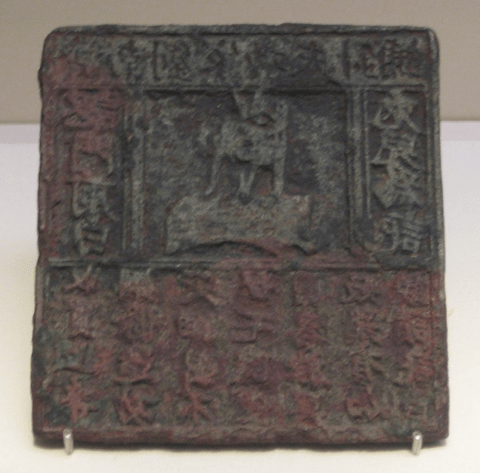
The plate was used by Jinan Liu's Fine Needle Shop to print posters complete with the store's name and a picture of a rabbit. The text translates to:
We buy high-quality steel rods and make fine quality needles, to be ready for use at home in no time.
2. Late 19th to early 20th century copywriting
In its modern form, English-language copywriting first appeared in the late 19th century.
It came with the explosion of print media and growth in literacy in the English-speaking world.
In the UK, for example, over three quarters of the population could read by 1870, about a third more than 50 years earlier.
Advertising and ad agencies were primarily focused on different forms of print media. This was the fertile ground from which the modern creative advertising industry grew from.
Today, there may seem to be a certain signature straight-talking style present in a lot of these old ads. The marketing strategy of them was generally used to promote businesses in the short-term.
But content marketing strategies began to evolve. Storytelling campaigns and advertising slogans became increasingly popular.
In 1896, beef extract paste Bovril began using the line 'Alas! My Poor Brother'. It was featured on posters depicting a bull looking at a jar of Bovril.
John Emory powers (1837 – 1919)
The American John Emory Powers was known as ‘advertising's most influential copywriter' and was probably the modern world's first professional copywriter.
He was famous for his direct and plain-speaking writing style. His advertising copywriting displayed this clearly. He once stated:
The commonplace is the proper level for writing in business, where the first virtue is plainness, ‘fine writing’ is not only intellectual, it is offensive.
The importance of ‘the commonplace' still resonates today, over 150 years later.
The principle works for digital advertising as well as for newspaper or magazine ads.
Powers also insisted on honesty in his copy. One ad he wrote for the department store Wanamaker's read:
“We have a lot of rotten gossamers and things we want to get rid of.”
The store sold out of these goods within hours.
3. Mid-20th century copywriting
Printed material continued to dominate modern copywriting in the middle of the 20th century.
Here is a magazine ad for Viyella Robes in 1949:

And here is the text for that ad:

The birth of modern creative advertising
Not all ads were detailed and lengthy. Some resembled the digital ads of today.
One example comes from the famous advertiser David Ogilvy (1911 – 1999). His long-running Rolls Royce advert began in 1959.
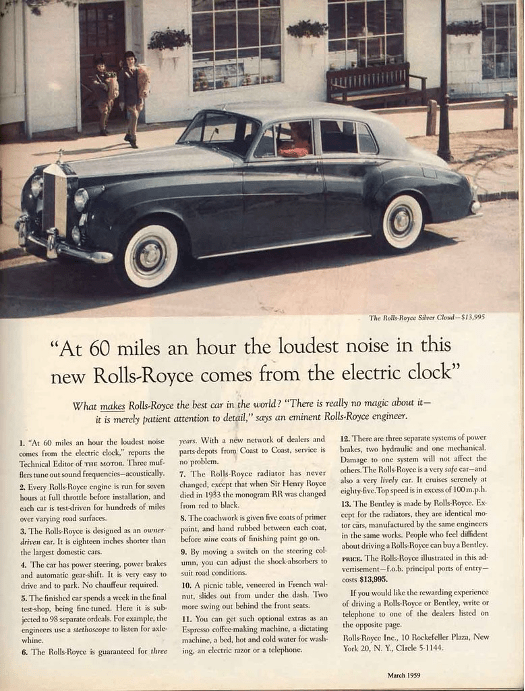
Rolls Royce even re-used a variation of this ad in 1982, when one of their campaigns included the line:
The loudest noise in a new Rolls-Royce is the beating of your heart.
4. Late 20th century copywriting
In the late 20th century copywriting was influenced by new mediums and cultural trends.
In advertising, the growth of radio, followed by television, was the biggest threat to print media (in 1946 7,000 televisions were sold in the US but sales reached 5 million in just four years).
Nike's Just Do It campaign
One famous example of advertising that effectively utilises copywriting from this era is Nike's “Just Do it” campaign.
It was first launched in 1988. And its slogan is credited with helping the brand increase its share of the North American market from $899 million to $9.2 billion over the following ten years.
In an age of fast food and short TV ads, “Just Do it” thrived as a positive, unique, and punchy slogan.
Ironically, what's less known is its surprisingly dark inspiration...
It was coined by marketer Dan Weiden. He later admitted he got the idea from an American murderer's last words before being executed: “Let's do it”.
5. Copywriting in the 21st century: the digital world
The internet has grown rapidly since it first entered mass market households in the mid-1990s.
It brought with it a whole new range of marketing and advertising mediums.
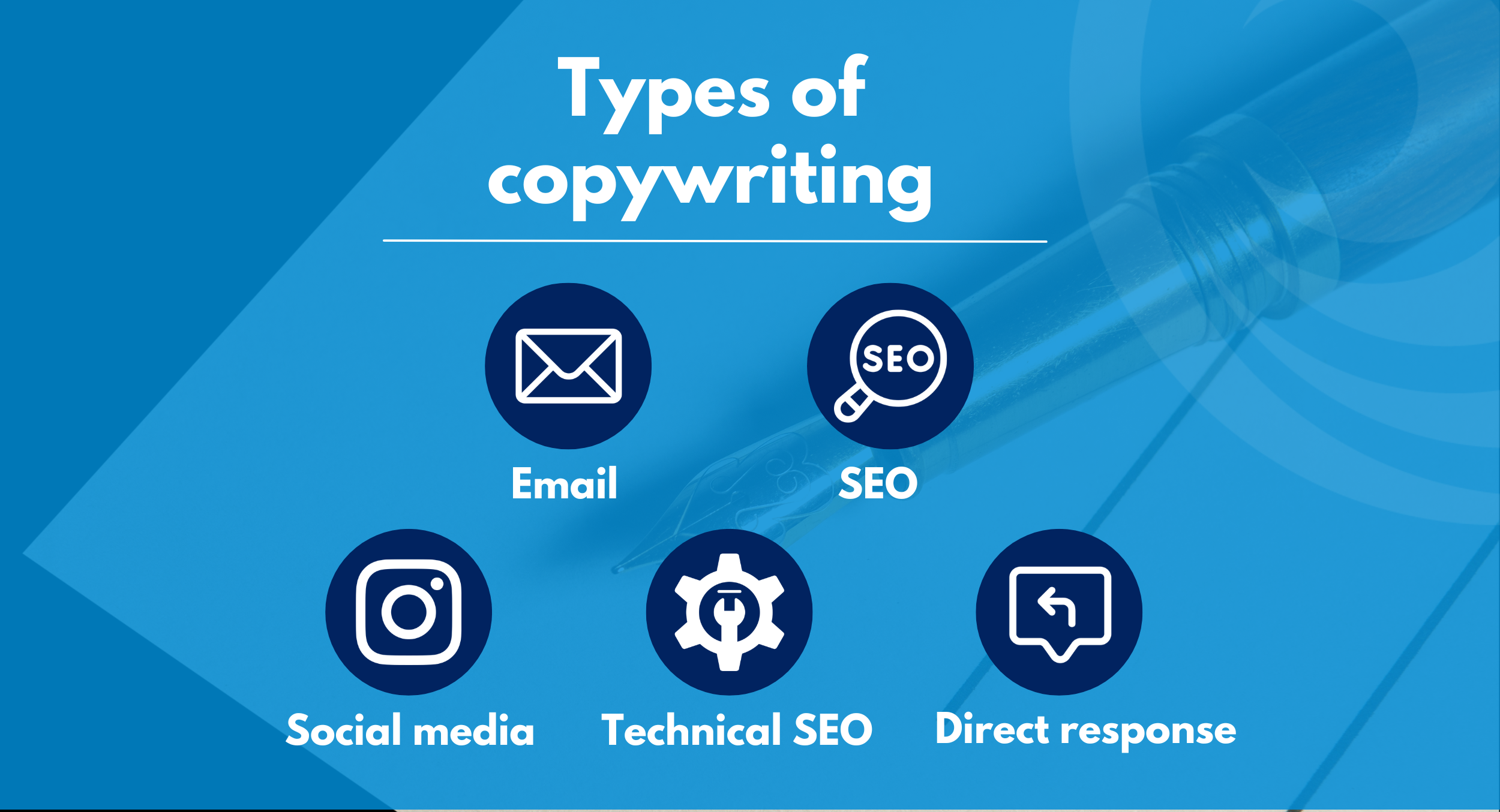
There are different claims for precisely how many types of copywriting exist. Besides general marketing copywriting, others include:
- Email copywriting
- Direct response copywriting (writing copy that has the goal of getting the reader to take an immediate action: purchase, sign up for a newsletter, follow on social media, etc.)
- Social media copywriting
- SEO copywriting
- Technical copywriting (including specialist scientific, technical, or medical copywriting)
There is overlap between many of these kinds of copywriting, though technical copywriting perhaps is commonly kept separate.
And each field has its own emphasis. For example, creating excellent ads for social media is about influencing purchasing or social decisions.
Advertising copywriting informed by digital analytics
In some ways, writing web copy is not that different to writing for print media.
After all, writing concise, memorable copy is universal marketing tactic employed by all of the best copywriters.
However, some points of difference exist. In our age of scientific advertising, tools for writing and measuring copywriting are important.
For example, measuring and utilising data from email headlines or paid advertising.
Businesses worldwide no longer need to rely intuition for planning.
Marketing communications can be informed by click-through rates (CTRs), engagement, and conversion metrics.
Clayton Makepeace (1952 - 2020): Highest paid advertising copywriter?
Clayton Makepeace (1952 - 2020) was possibly the highest paid copywriter of the early 21st century, making up to $3 million a year.
He specialised in direct response copywriting and known for his “emotional style of writing”.
In an obituary, one of his former students, copywriter David Deutsch, remarked that he:
“constantly demonstrated the power and magic of simply putting the right words together.”
Copywriting for SEO best practices
Search engines optimisation (SEO) brings the need to optimise some blogs (and many web pages) for specific keywords.
This is obviously something advertising copy for print didn't need.
So, copywriting for SEO now requires initial keyword and competition research.
To the uninitiated, this may seem intimidating at first. This is where understanding what is the purpose of a blog becomes essential.
Once keyword research is done, a worthy copywriter should be able to help the content reach.
Because once content gains good SEO rankings, its viewership should increase significantly.
However, there are still other factors outside of the copy itself that count (such as the domain authority, topical authority, backlinks, technical issues, etc).
But like the first printed material, SEO copywriting still requires basic best practices around writing clear and concise copy.
Copywriting for blogs
Today, despite the apparent immediate nature of many online experiences, less direct advertising exists and thrives.
Here, we are talking about blogs.
The word 'blog' comes from 'web log'. It originally appeared in 1999, when blogs were largely seen as online journals.
But since the rise of the internet in the past few decades, the purpose of blogs has rapidly evolved and proliferated.
Now, blogs can be divided into two main categories:
- SEO blogs
- Thought leadership blogs
Within these categories, there is more or less a spectrum between informational and commercial purpose.
And the strategic placement of more informational content that links to more commercial content is part of a wider content strategy.
So, good blog copywriting needs to reflect the intent of the piece.
In other words, some blogs need to focus on being informative, whilst others need to be persuasive.
Copywriting and content writing
Whilst there is some overlap, copywriting and content writing are two different disciplines.
In short, copywriting is for more persuasive and aimed at conversion with concise text.
Its grammar can be flexible, as with slogans like Apple's "Think Different." It utilises psychology and creativity.
Content writing, on the other hand, is based on being educational. It builds assets that are for building trust before driving sales. It demands good grammar and in-depth topic understanding.
The future of copywriting
At its core, copywriting is the art of using language to market products and services.
Just as those products and services will change or disappear eventually, so too will elements of the language and style we use.
Each new platform will have its own target audience that will have its own requirements.
AI copywriting
AI technology is evolving fast.
It was once something writers only dreamed of. In Roald Dahl's 1953 short story 'The Great Automatic Grammatizator', the main character dreams up a machine for writing novels:
Then suddenly, he was struck by a powerful but simple little truth, and it was this: that English grammar is governed by rules that are almost mathematical in their strictness!
Today, many marketers are already noticing AI's ability at creating ads, writing direct mail and marketing copy more broadly.
ChatGPT and Google's Bard are two of the most popular tools for doing this.
Maintaining creative input is crucial for copywriters to ensure AI-generated content aligns with the brand's voice and values.
ChatGPT is known to have a monotonous tone when generating copy. It’s not difficult to spot AI written copy.
Users of ChatGPT will also know the repetitive and cliche phrases it uses.
However, AI has many significant benefits including automation, time efficiency, analysing data, brainstorming and more.
To maximise the benefits of AI, we recommend it as an assistant to copywriters. Copywriters and marketers should be the operators, managing ChatGPT and any AI tools.
Having the right balance between AI assistance and a copywriter’s expertise, is essential in this era of AI technology.
At present, the ability to write good prompts for AI is essential if you want to utilise it for copywriting. In this sense, it looks set to at least become a part of the creative process.
Whether it will go on to completely supplant influential copywriters remains to be seen...
Conclusion
Copywriting has arguably been around for millennia.
In its modern form, in English, it has been a core element of marketing (and a fulltime profession) since the late 19th century.
Culture, language, platforms and products have changed greatly since then.
And new industries, such as fintech, continue to appear and evolve. They come with their own culture and requirements, such as an emphasis on technical knowhow and trust.
Like our ancestors, today’s copywriters are continuing to adapt and specialise in new domains.
But whether it’s a scribe in ancient Egypt, an advertising man in late 19th century New York, or a 21st century fintech copywriter in London, the importance of simply putting the right words together will always be at the core of marketing.
With the emergence of AI, smaller brands might start to experiment with low-cost machine generated copy.
But for real copy creativity, the human mind still reigns supreme, at least for now…
